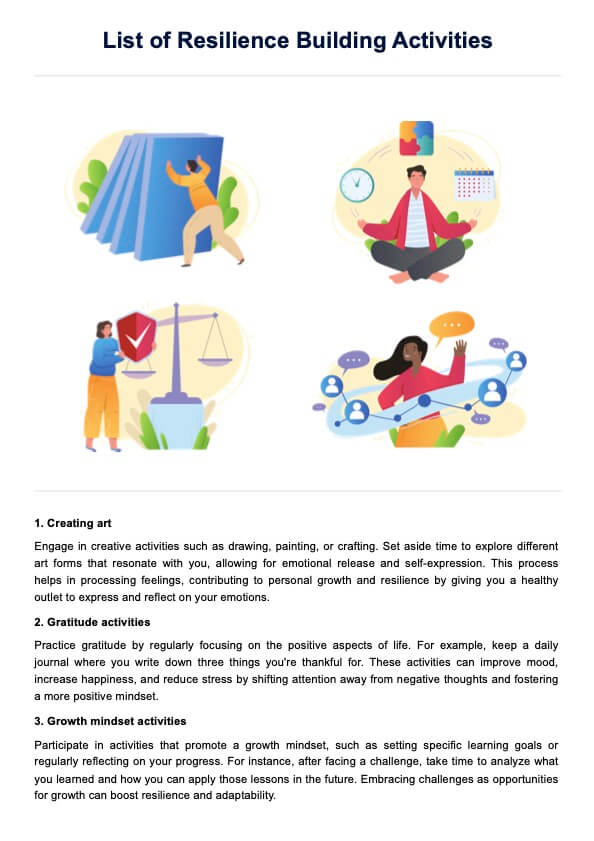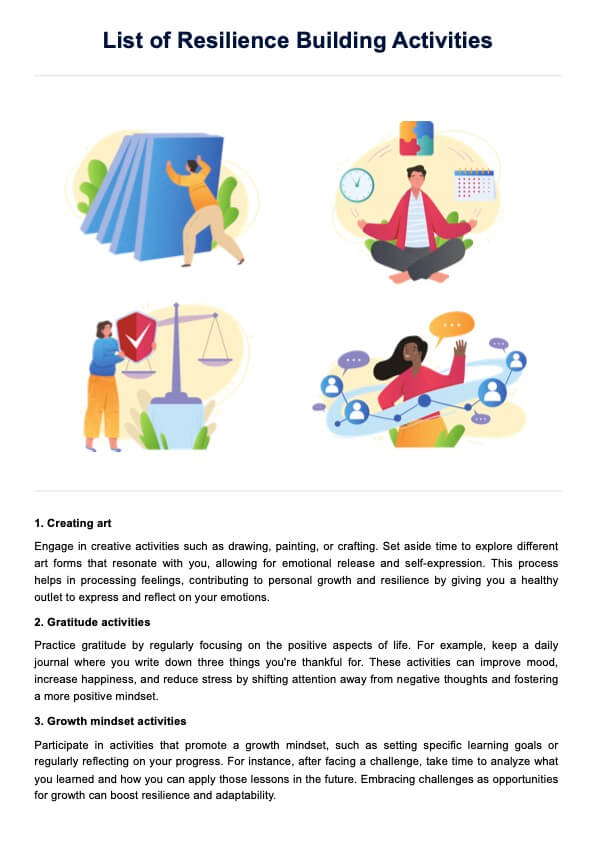List of Resilience Building Activities
Help clients overcome setbacks and face life with vigor. Download this List of Resilience Building Activities PDF for free to improve their well-being.


What does it mean to build resilience?
Developing resilience can be challenging, especially for those who have been sheltered and are unfamiliar with setbacks. Resilience is not about avoiding problems or ensuring everything goes smoothly. Rather, it involves adapting effectively to life's difficulties.
According to the American Psychological Association Dictionary of Psychology (2018), resilience is the process and outcome of successfully adapting to challenging experiences through mental, emotional, and behavioral flexibility. Several factors influence how well individuals adapt to adversity, including (a) their outlook on and engagement with the world, (b) the quality of their social support, and (c) their coping strategies.
Life fosters resilience, not just in adults. Teaching resilience even to younger kids can help them build strong relationships and achieve their goals without being hindered by failure or problems. Resilient children are better equipped to handle life's ups and downs. They tend to develop life skills like strong problem-solving skills, maintaining a positive outlook, and bouncing back more quickly from setbacks in everyday life.
List of Resilience Building Activities Template
List of Resilience Building Activities Example
10 resilience building activities
We've compiled a list of activities you can incorporate into your practice. Here are they:
1. Creating art
Encourage clients to express themselves through creative activities like drawing, painting, or crafting. Art can be a form of emotional release and personal growth, helping people process their emotions and build resilience.
2. Gratitude activities
Practicing gratitude helps build a more positive mindset and can strengthen emotional resilience. Gratitude activities involve regularly focusing on the positive aspects of life, such as writing down things one is thankful for each day. By shifting attention away from negative thoughts, these activities can improve mood, increase happiness, and reduce stress.
3. Growth mindset activities
Incorporate activities that promote a growth mindset, such as setting learning goals or reflecting on progress. Individuals can enhance their resilience and adaptability by focusing on continuous improvement and viewing challenges as opportunities.
4. Mindfulness meditation
When problems arise, solving them needs concentration. Concentration involves intense focus, and mindfulness meditation sessions can help. This practice can enhance self-awareness and emotional regulation, allowing individuals to manage stress more effectively and build resilience against life's challenges while basking in the present moment.
5. Positive relationships building
Building and maintaining positive relationships through social activities or support groups helps in enhancing resilience skills of clients. Strong connections with others provide emotional support, which is crucial for resilience, especially during tough times.
6. Positive self-talk practice
Teach individuals to practice positive self-talk by replacing negative thoughts with encouraging ones and thinking of the positive aspects of life. This activity can enhance emotional resilience by promoting a positive mindset and helping people overcome obstacles. For example, when they catch themselves thinking, "I can't do this," suggest they rephrase it to, "This is tough, but I can handle it."
7. Problem-solving skills workshop
During a session, you can host a workshop focused on developing problem-solving skills. By approaching life's challenges with a proactive and solution-oriented mindset, individuals can build resilience and feel more equipped to handle difficult situations.
8. Random acts of kindness
Encourage clients to perform random acts of kindness, such as helping a neighbor, volunteering at a local charity, or offering a kind word to someone in need. These actions can boost positive emotions and contribute to resilience by reinforcing a sense of purpose and connection with others.
9. Resilience building journey
Help participants map out their personal resilience-building journey by setting goals and tracking progress. Suggest they start by identifying areas where they want to improve, then break these down into manageable steps. Regularly reviewing and adjusting goals based on their experiences can strengthen resilience and boost self-confidence.
10. Stress management techniques
Introduce various stress management techniques, such as deep breathing exercises or relaxation techniques. A few deep breaths can manage stress and build resilience by teaching individuals how to stay calm and focused during stressful situations.
How to use our resilience-building activities list
Resilience training doesn't happen overnight, but by using our list, you can start helping your clients cultivate it gradually. Here are some steps to follow:
Step 1: Download the list
Begin by downloading the List of Resilience Building Activities. You can save it digitally or print it out to use during sessions with your clients.
Step 2: Review the activities
Familiarize yourself with the activities on the list. Each activity enhances resilience, so consider which ones align with your client's needs and goals. Select a few activities that resonate with your client. Start with one or two to avoid overwhelming them, and gradually introduce more as they progress.
Step 3: Instruct clients on scheduling
Encourage your client to schedule regular times for these activities. Explain that setting aside specific times can help them build a routine, making the activities more effective in developing resilience.
Step 4: Facilitate reflection
After your client completes an activity, prompt them to reflect on the experience. Discuss how the activity impacted their mood, mindset, or coping strategies.
Benefits of building resilience
Here are some benefits of building resilience supported by studies:
Enhances mental health
Resilience helps individuals manage and recover from stress and adversity, leading to better mental health outcomes.
Understanding resilience is crucial for promoting optimal development in children and adolescents at risk for psychiatric disorders. Higher resilience levels are linked to fewer mental health issues, highlighting the importance of including social, cultural, and family contexts in research and interventions to improve outcomes (Mesman et al., 2021).
Strengthens coping resources
Positive emotions are shown to improve psychological and physical well-being by enhancing coping strategies. Research revealed that psychological resilience and positive emotional granularity, effectively managing negative events with positive emotions, contribute significantly to better health outcomes (Tugade et al., 2004).
Improves well-being and performance
Resilience training often improves psychosocial functioning and performance (Sarkar & Fletcher, 2017). Resilience at work is crucial for managing stress, adapting to change, and maintaining productivity during challenging times.
References
American Psychological Association. (2018, April 19). Resilience. https://dictionary.apa.org/resilience?fbclid=IwAR3Pm8Pip_rO4kiTi6EDrsG3zcESXeOzNMRDwgCC7
Mesman, E., Vreeker, A., & Hillegers, M. (2021). Resilience and mental health in children and adolescents. Current Opinion in Psychiatry, 34(6). https://doi.org/10.1097/yco.0000000000000741
Sarkar, M., & Fletcher, D. (2017). How Resilience Training Can Enhance Well-being and Performance. In Managing for Resilience. Routledge. https://www.taylorfrancis.com/chapters/edit/10.4324/9781315648033-14/resilience-training-enhance-wellbeing-performance-mustafa-sarkar-david-fletcher
Tugade, M. M., Fredrickson, B. L., & Feldman Barrett, L. (2004). Psychological resilience and positive emotional granularity: Examining the benefits of positive emotions on coping and health. Journal of Personality, 72(6), 1161–1190. https://doi.org/10.1111/j.1467-6494.2004.00294.x
Commonly asked questions
Resilience is necessary because it helps people adapt to and recover from life's challenges, making them stronger and more capable of handling future difficulties.
Yes, resilience can be developed later in life through intentional practices such as stress management, building supportive relationships, and fostering a growth mindset.
Team building activities for resilience are group exercises that strengthen a team's ability to work together, handle stress, and support each other during difficult situations. An example is a problem-solving challenge in which team members must collaborate to find solutions under pressure, building trust and resilience.




















-template.jpg)



















































































